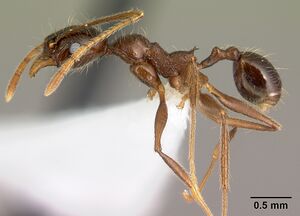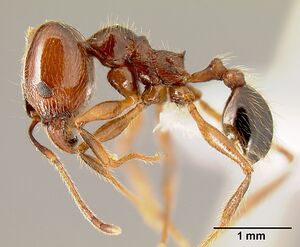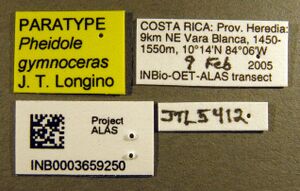Pheidole gymnoceras
| Pheidole gymnoceras | |
|---|---|

| |
| Scientific classification | |
| Kingdom: | Animalia |
| Phylum: | Arthropoda |
| Class: | Insecta |
| Order: | Hymenoptera |
| Family: | Formicidae |
| Subfamily: | Myrmicinae |
| Tribe: | Attini |
| Genus: | Pheidole |
| Species: | P. gymnoceras |
| Binomial name | |
| Pheidole gymnoceras Longino, 2009 | |
This species inhabits mid-elevation wet forest. During ALAS project sampling of the Barva transect it was found at the 1100m and 1500m sites. At the 1100m site it was most frequently captured in flight intercept traps, suggesting it is an epigaeic forager. At the 1500m site (Finca Murillo) a small queenrite nest was found beneath rotten wood; the workers had a foetid odor. (Longino 2009)
Identification
With the morphometric profile of Pheidole aciculata, minor workers very similar to the sympatric Pheidole indagatrix. Minor worker: scape with all setae shorter than maximum width of scape versus with many erect setae longer than maximum width of scape (aciculata, indagatrix); hind femur with subdecumbent setae on dorsal surface versus with suberect setae on dorsal surface (aciculata, indagatrix). Major worker: relative to aciculata, inner hypostomal teeth more widely spaced; mesosoma less shiny; scapes with shorter setae; hind femur with dorsal setae subdecumbent versus suberect; sides of head with shorter, less erect setae; posterior margin of head more cordate. (Longino 2009)
Distribution
Latitudinal Distribution Pattern
Latitudinal Range: 12.9599821° to 9.7509026°.
| North Temperate |
North Subtropical |
Tropical | South Subtropical |
South Temperate |
- Source: AntMaps
Distribution based on Regional Taxon Lists
Neotropical Region: Costa Rica (type locality), Nicaragua.
Distribution based on AntMaps
Distribution based on AntWeb specimens
Check data from AntWeb
Countries Occupied
| Number of countries occupied by this species based on AntWiki Regional Taxon Lists. In general, fewer countries occupied indicates a narrower range, while more countries indicates a more widespread species. |

|
Estimated Abundance
| Relative abundance based on number of AntMaps records per species (this species within the purple bar). Fewer records (to the left) indicates a less abundant/encountered species while more records (to the right) indicates more abundant/encountered species. |

|
Biology
Castes
Worker
Minor
Images from AntWeb
   
| |
| Paratype Pheidole gymnoceras. Worker. Specimen code casent0608958. Photographer Erin Prado, uploaded by California Academy of Sciences. | Owned by CAS. |
    
| |
| Paratype Pheidole gymnoceras. Worker. Specimen code casent0609233. Photographer J. Russ, uploaded by California Academy of Sciences. | Owned by INBC. |
Major
     
| |
| . | |
Queen
   
| |
| . | |
Nomenclature
The following information is derived from Barry Bolton's Online Catalogue of the Ants of the World.
- gymnoceras. Pheidole gymnoceras Longino, 2009: 34, fig. 8 (s.w.) COSTA RICA.
Unless otherwise noted the text for the remainder of this section is reported from the publication that includes the original description.
Description
Worker
Minor Measurements (paratype): HL 0.83, HW 0.63, HLA 0.30, SL 1.17, EL 0.20, ML 1.11, PSL 0.10, PMG 0.04, SPL 0.04, PTW 0.13, PPW 0.19, CI 76, SI 185, PSLI 12, PMGI 5, SPLI 5, PPI 150.
Measurements (n=9): HL 0.78-0.85, HW 0.59-0.65, SL 1.10-1.17, CI 74-77, SI 176-190.
Mandible and clypeus smooth and shining; face with a few concentric rugae around antennal insertion, small patch of foveolate sculpture between frontral carina and compound eye; rest of face smooth and shining; margin of vertex rounded; occipital carina narrow, visible in full face view; scape with dense suberect setae but all shorter than maximum width of scape; promesonotal groove present, conspicuous; propodeal spines present; pronotum with patches of foveolate sculpture on humerus and anterior border, smooth and shining elsewhere; katepisternum and lateral and dorsal faces of propodeum foveolate overlain with inconspicuous rugulae; abundant setae on promesonotal dorsum; dorsal (outer) margin of hind tibia with abundant suberect setae, some longer than maximum width of tibia; dorsal face of hind tibia with setae appressed to subdecumbent; first gastral tergum smooth and shining; gastral dorsum with abundant suberect setae; color red brown.
Major Measurements (holotype): HL 1.42, HW 1.39, HLA 0.40, SL 1.07, EL 0.24, ML 1.43, PSL 0.08, PMG 0.04, SPL 0.06, PTW 0.26, PPW 0.34, IHT 0.50, OHT 0.57, CI 98, SI 77, PSLI 6, PMGI 3, SPLI 4, PPI 130, HTI 88.
Mandible smooth and shiny; clypeus smooth and shining, flat, with distinct anterior notch; short longitudinal rugae between mandibular insertion and compound eye, a few concentric rugae around antennal insertion, grading to reticulate rugae between frontal carina and compound eye, rest of face smooth and shining; head with abundant short subdecumbent setae projecting from sides of head in face view; scape smooth and shining, terete at base, with abundant short subdecumbent setae, none longer than maximum width of scape; hypostomal margin straight; median tooth absent; inner hypostomal teeth thin and sharp, widely-spaced, much closer to outer hypostomal teeth than to midline; promesonotal groove present; propodeal spines present; pronotum smooth and shining with small irregular patches of faint foveolate sculpture; katepisternum smooth and shining anteriorly, grading to rugose-foveolate posteriorly and on lateral and dorsal faces of propodeum; dorsal (outer) margin of hind tibia with abundant suberect setae, some longer than maximum width of tibia; pilosity abundant on mesosomal dorsum; postpetiole in dorsal view globular; first gastral tergite smooth and shining, with abundant suberect setae; color red brown.
Type Material
Holotype major worker. Costa Rica, Heredia: 10km NE Vara Blanca, 10.23333°N 84.08333°W, ±2000m, 1500m, 9 Feb 2005 (J. Longino#5412) Instituto Nacional de Biodiversidad, unique specimen identifier INB0003659251.
Paratypes: major and minor workers. Same data as holotype The Natural History Museum, California Academy of Sciences, EAPZ, ECOSCE, Field Museum of Natural History, Instituto Nacional de Biodiversidad, John T. Longino Collection, Los Angeles County Museum of Natural History, Museum of Comparative Zoology, Musee d'Histoire Naturelle Genève, Instituto de Zoologia Agricola, Museu de Zoologia da Universidade de Sao Paulo, MEL, University of California, Davis, UNAM, ICN, National Museum of Natural History.
Etymology
The name is in reference to the lack of longer erect setae on the scape of the minor worker.
References
- Longino, J.T. 2009. Additions to the taxonomy of New World Pheidole. Zootaxa 2181: 1-90. PDF
References based on Global Ant Biodiversity Informatics
- Longino J. T. 2009. Additions to the taxonomy of New World Pheidole (Hymenoptera: Formicidae). Zootaxa 2181: 1-90.
- Longino J. T. L., and M. G. Branstetter. 2018. The truncated bell: an enigmatic but pervasive elevational diversity pattern in Middle American ants. Ecography 41: 1-12.
- Longino J. et al. ADMAC project. Accessed on March 24th 2017 at https://sites.google.com/site/admacsite/

